#Tony Geraghty
Explore tagged Tumblr posts
Text
#OTD in 1975 – Miami Showband massacre | UVF volunteers (some of whom were also UDR soldiers) shot dead three members of an Irish showband at Buskhill, Co Down.
Three members of the Miami Showband are killed by Ulster Volunteer Force members posing as members of the security forces when returning from a performance at The Castle Ballroom in Banbridge, Co Down. (Four of the killers were actually members of the Ulster Defence Regiment (UDR), an official reserve force for the British army). At the time, the Miami Showband were one of the most popular…
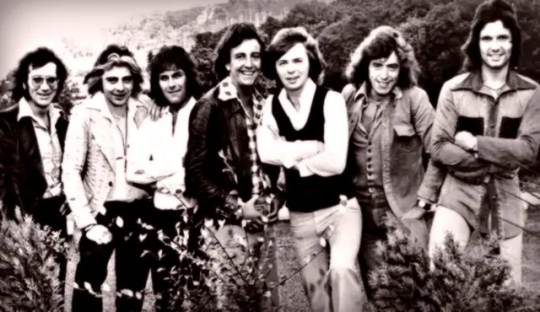
View On WordPress
#Banbridge#Brian McCoy#Co. Down#Dublin#Fran O’Toole#Monument#Parnell Square North#The Castle Ballroom#The Miami Showband#Tony Geraghty#UDR#Ulster Defence Regiment#Ulster Volunteer Force#UVF
9 notes
·
View notes
Text

June 1975
2 notes
·
View notes
Text

Who Dares Wins by Tony Geraghty
Duty Free: "El Astro"
0 notes
Text


tony.
Tony Banks at Newcastle City Hall, April 29th, 1980 by Kevin Geraghty-Shewan
18 notes
·
View notes
Text
Either Gaslit Is A Good Show, Or I’m Just Getting Old
*This Here Blog Post Contains Mad Spoilers*

Gaslit was not made for me.
Demographic-wise, theme-wise, and in as far as the contents of the show, and the period in history that they are talking about, this is not a show that was created to appeal to, or entertain, an early thirties, black, male, South African.
And yet, for as old as the medium of television is, and for all the historically great entertainment it’s served up through the decades, you just know when a show has nailed it.

Gaslit is a non-fictional re-telling of Richard Nixon’s Attorney General, John Mitchell, and how his strained relationship with his wife served to exasperate Nixon’s problems during the public dissemination of Watergate scandal.
That’s among the show’s first risky decisions.
The decision to tell one of the major stories at the heart of the Watergate scandal, in as historically accurate of a way as possible, was risky. Consider that these events took place more than 50 years ago, and for the most part, you know how it’s supposed to end, because you know how Nixon’s time as president ended.
Keep in mind, Robert Redford and Dustin Hoffman have already made the film “All The President’s Men” in 1976, and that film’s release had the advantage of the Watergate scandal being fresh in the minds of the American public.
So this show has to sell the detail rather than the narrative itself. It has to sell process over outcome, and it has to sell the journey over the destination. An interesting challenge that I think the producers and artisans involved took to very well.

The casting of Julia Roberts as Martha Mitchell, does wonders for the part of the show that gets the most narrative and thematic attention. Sean Penn plays her husband, John Mitchell, who gets himself in a bind when he undertakes and fails, an operation to bug and gather intelligence from the Watergate building.
Those are just the casting choices at the top of the marquee.
Craig Bauer is phenomenal in his performance as the incompetent, John McCord. Shea Whigham is awesome in his role as the acerbic Gordon Liddy, Dan Stevens is the show’s understated comic relief in his role as John Dean, and ofcourse Brian Geraghty finds a way to show his face, like he does every other crime drama show in North American television.
Thing of it is that, that’s just the casting, and as important as that is, and as well done as it was, it still doesn’t quite account for all of what we’re seeing. I simply cannot accept that as the sole reason for the show being what it is.

The focus on the relationship dynamics between the show’s power couple is interesting, well written, well layered, and well portrayed by the performers in question, however, if it was the only thing the show offered, it would be less impressive.
That, and the fact that marital dysfunction is not new to television drama.
The show also pulls off something that a lot of great shows will also do, by not being held to genre conventions. Instead opting for a kind of blending of genres that include historical drama, comedy/dark humor and political intrigue, to create a kind of thematic cocktail.
The core conflict at the center of the show is nicely ratcheted up when John Mitchell’s henchmen’s attempts at bugging the Watergate building are foiled by local police detectives, and in a kind of pre-emptive, paranoid and distrustful move, he opts to have his wife temporarily imprisoned, in fear that she might divulge both John and Richard Nixon’s involvement in Watergate to the media.
The best television drama shows have always relied on a strong paring like this.
Tony and Carmela Soprano quickly come to mind, Walter and Skyler White had a similar dynamic in Breaking Bad, and when the traumatic effects of Martha Mitchell’s 24 hour imprisonment at the hands of Peter (played by Brian Geraghty), are completely lost on John Mitchell, Martha realizes John is going to be the “fall guy” for Nixon’s scandal, and she resorts to subtly making herself more available to the media and publicly protesting his innocence on his behalf.
It was crucial that the show nail Martha and John’s marital tension, or risk the entire show falling on it’s head. However, something can be vitally important without being the biggest reason for success, especially in the medium of audio-visual storytelling.

No, what makes this show successful, is a commitment to absurdity.
Absurdity was what made Watergate the spectacle that it was.
The absurd idea that Richard Nixon thought he could get away with KGB-style intelligence tactics against his political opposition, and the idea that it almost worked because he won his re-election campaign.
The absurdity of the idea that they thought they would be able to keep the story quiet even after their henchmen were caught in the act.
The absurdity of a man with as much conviction as John Mitchell, having a cult-like devotion to Richard Nixon. A devotion no different to that which some Kremlin members had for Josef Stalin in the decade before, and all made more absurd by the fact that Mitchell is willing to take the fall for a crime he was instructed to commit.
In episode 4, a hungover Martha walks in to her living room after the Mitchell’s had just hosted a birthday party, and sees her husband seated on the floor like a child, watching Nixon address the American public with eyes entranced by his television screen, and at that point she realizes her husband does not have the will, the capability, nor does he see the need to defend himself from what’s going to happen to him next.
However, the most absurd of all, are the henchmen that were caught in the deed, and their belief that somehow, President Nixon would save, pardon, exonorate or bail them out, in any way, in the event that they were caught.

Moreover, Gaslit is a story about what happens when powerful people manage to surround themselves with only loyalists, and it’s a story about what happens when abuse of power becomes the norm.
In Episode 1, John Dean is walked into John Micthell’s office and offered the task of overseeing the bugging of the Watergate building.
At first he balks at the obvious bad legal implications of such an idea. He is then challenged by the Attorney General, and has his capabilities, ambition and loyalty questioned, after which Dean begins to put forth ideas on the best way to go about the operation.
While the episode 1 interaction between Dean, A.G John Mitchell and Mitchell’s fixer, Jeb Macgruder is hilarious, it is also the kind of interaction that cannot happen in an atmosphere where abuse of power isn’t the norm.
At the heart of most of Gaslit’s dark humour is how this kind of belief in power and the ambivalence towards the injustices it commits, is it’s own kind of delusional, and even it’s own kind of mental illness.
This is best exemplified by the men that were caught in the act of actually bugging the building itself.

Gordon Liddy is a case study in how religious zealotry and belief in a higher purpose can go wrong, and how religious and cultural backgrounds that teach adherence to authority, are like breeding footsoldiers for corrupt leaders. Liddy proves this to the extent of using violence to maintain the silence of the others when they are tried and convicted for breaking and entering.
John Dean’s belief that he is somehow “close to the President”, shows the kind of benign dishonesty that a cult of personality like Nixon’s breeds because proximity to him is like it’s own social currency, and that can easily be corrupted when careerists like Dean decide to “play the game” and use that to thier advantage.
James McCord, is really the worst victim of this. He was a bad fit for the operation from the start and the realization that John Mitchell, whom he served personally, is not going to save him from a lengthy prison sentence, is the beginning of the end of the collective belief in Nixon.
Whether it’s John Mitchell, way up in the hierachy of Washington, or poor old James McCord down at the bottom, all the men in this show suffer from a belief in the cult and power of a President that, for all intents and purposes, only cared about being in power.
Among the show’s sub-narratives is allowing you to revel in the shattering of the collective and unquestioning belief in their leader, but the biggest casualty of standing in that truth was Martha Mitchell.
youtube
#tv#tv shows#series#drama#julia roberts#sean penn#chris bauer#dan stevens#shea whigham#starz#watergate#nixon#richard nixon#scandal#all the president's men#gaslit#dark comedy#dark humour#long post
4 notes
·
View notes
Text
I should also add that they also protected Robert Nairac, who was involved in the Miami Showband massacre. The plan there was to blow up Ireland's most popular showband and make it look like they were smuggling explosives to the IRA, ending a ceasefire and giving the British government a really good reason to lock down the border to Northern Ireland. The bomb exploded prematurely, killing two members of the UVF. The remaining terrorists then opened fire on the rest of the band as they fled, seriously wounding bassist Stephen Travers, and killing singer Fran O'Toole (who was shot 8 times in the face), guitarist Tony Geraghty, and trumpeter Brian McCoy. Like in the Bloody Sunday murders, the British government hauled ass to protect the soldiers and informants involved. One even was set to receive a fucking posthumous medal last I knew.
The British government needs to be held to task for every Irish civilian that they murdered during the troubles, either directly or indirectly. Fuck these bullshit attempts to cover their asses when we all know the monarchy isn't worth a fucking shit anyway.
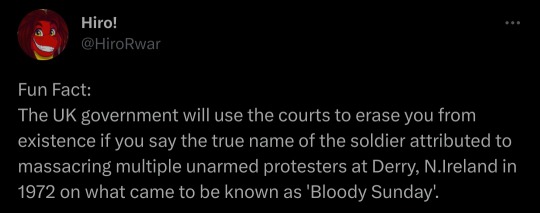
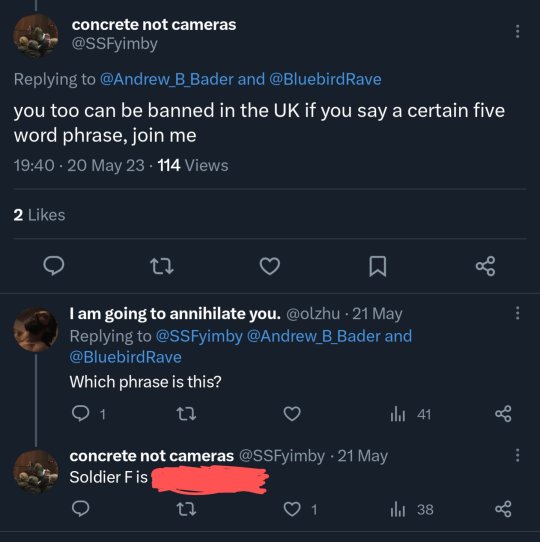

135K notes
·
View notes
Text
An affair between the second in line to Britain’s throne and the princess of the feuding Irish spells doom for the young lovers. Credits: TheMovieDb. Film Cast: Tristan: James Franco Isolde: Sophia Myles Marke: Rufus Sewell Donnchadh: David O’Hara Wictred: Mark Strong Melot: Henry Cavill Bragnae: Bronagh Gallagher Bodkin: Ronan Vibert Edyth: Lucy Russell Leon: JB Blanc Morholt: Graham Mullins Simon: Leo Gregory Orick: Dexter Fletcher Aragon: Richard Dillane Kurseval: Hans Martin Stier Kaye: Thomas Morris Anwick: Jamie Thomas King Rothgar: Wolfgang Müller Lady Serafine: Cheyenne Rushing Lady Marke: Barbora Kodetová Young Isolde: Isobel Moynihan Young Tristan: Thomas Brodie-Sangster Tournament Judge: Gordon Truefitt Young Melot: Myles Taylor Young Simon: Jack Montgomery Luther: Marek Vašut Irish Soldier: David Fisher Lady Aragon: Bronwen Davies Paddreggh: Philip O’Sullivan Tournament Crier: Nevan Finegan Coronation Priest: Jón Ólafsson Widseth: Todd Kramer Widseth’s Sister: Winter Ave Zoli Pict Guard: Miroslav Šimůnek Funeral Priest: Kevin Flood Film Crew: Director: Kevin Reynolds Music: Anne Dudley Editor: Peter Boyle Director of Photography: Artur Reinhart Executive Producer: Jim Lemley Casting: Kate Dowd Executive Producer: John Hardy Producer: Moshe Diamant Producer: Lisa Ellzey Producer: Giannina Facio Producer: Elie Samaha Executive Producer: Ridley Scott Executive Producer: Tony Scott Production Design: Mark Geraghty Set Decoration: Johnny Byrne Costume Design: Maurizio Millenotti Costume Supervisor: Hana Kučerová Writer: Dean Georgaris Executive Producer: Frank Hübner Executive Producer: Matthew Stillman Co-Producer: Anne Lai Co-Producer: Jan Fantl Co-Producer: Morgan O’Sullivan Co-Producer: James Flynn Stunt Coordinator: Nick Powell Unit Production Manager: John J. Kelly First Assistant Director: Robert Huberman Associate Producer: David Minkowski Associate Producer: Christian Frohn Associate Producer: Jennifer Leshnick Associate Editor: Pamela Power Associate Editor: Stephen Boucher Hairstylist: Stefano Ceccarelli Hairstylist: Jiří Farkaš Hairstylist: Alena Marečková Hairstylist: Mario Michisanti Hairstylist: Adéla Robová Hairstylist: Jaroslav Šámal Key Hair Stylist: Mirella Ginnoto Key Makeup Artist: Manlio Rocchetti Art Department Coordinator: Marketa Puzmanova Assistant Art Director: David Voborský Assistant Art Director: David Vondrasek 3D Animator: Ales Dlabac 3D Animator: Zbynek Travincky Visual Effects Supervisor: Jaroslav Polensky Title Designer: Anthony Wonsoff Visual Effects Coordinator: Jan Vseticek Visual Effects Producer: Vít Komrzý Visual Effects Supervisor: Marius Mohnssen Special Effects Supervisor: Pavel Sagner Special Effects Supervisor: Kevin Byrne Additional Still Photographer: Larry D. Horricks Camera Operator: Erwin Lanzensberger Camera Operator: Kacper Lisowski Second Unit Director of Photography: Miro Gábor Gaffer: Tony Devlin Key Grip: Helge Felgendreher Key Grip: Ivo Grešák Rigging Gaffer: Kriz David Still Photographer: Rico Torres Casting: Nancy Bishop Casting: Anja Dihrberg Casting: Kirsty Kinnear Assistant Costume Designer: Giovanni Casalnuovo Assistant Costume Designer: Mariano Tufano Costume Supervisor: Šárka Zázvorková Costume Supervisor: Sarka Zvolenska Key Costumer: Cathy Smith Seamstress: Larisa Šrámková Set Costumer: Rebecca Higginson Digital Intermediate: Mandy Rahn Assistant Editor: Geraint Huw Reynolds Music Editor: Sophie Cornet Music Editor: John Warhurst Script Supervisor: Catherine Allinson Script Supervisor: Peter J. Clark Choreographer: Lucie Samcova ADR Editor: Gareth Rhys Jones Boom Operator: Roman Rigo Foley: Jack Stew Foley Editor: Sefi Carmel Sound Designer: Samir Foco Sound Designer: Zeljko Lopicic-Lepierre Sound Effects Editor: Peter Crooks Sound Re-Recording Mixer: Howard Bargroff Sound Re-Recording Mixer: Graham Daniel Sound Re-Recording Mixer: Martin Schinz Sound Effects Editor: Srdjan Kurpjel Standby Art Director: Rory Bruen Movie Reviews:
#6th century#Battle#Castle#hostility#in love with enemy#Knight#Lovers#middle ages (476-1453)#murder#Revenge#star crossed lovers#Top Rated Movies
1 note
·
View note
Text
¿Cuáles son los mejores corredores de caballos en el Cheltenham Horse Racing?
🎰🎲✨ ¡Obtén 500 euros y 200 giros gratis para jugar juegos de casino con solo un clic! ✨🎲🎰
¿Cuáles son los mejores corredores de caballos en el Cheltenham Horse Racing?
Entrenadores destacados en Cheltenham
Los entrenadores destacados en Cheltenham son reconocidos por su habilidad y experiencia en el mundo de las carreras de caballos. Cheltenham es conocido por ser uno de los hipódromos más prestigiosos de Reino Unido, por lo que solo los mejores entrenadores logran destacarse en este escenario tan competitivo.
Entre los entrenadores más destacados en Cheltenham se encuentra Nicky Henderson, quien ha cosechado numerosos éxitos a lo largo de su carrera, incluyendo múltiples victorias en el Festival de Cheltenham. Otro entrenador de renombre es Paul Nicholls, cuyos caballos han demostrado su calidad y clase en las pistas de Cheltenham en varias ocasiones.
Además, no podemos olvidar a Jonjo O'Neill, cuya habilidad para preparar a sus caballos para las carreras ha sido ampliamente reconocida en la industria hípica. Otro entrenador destacado en Cheltenham es Colin Tizzard, cuyos caballos han logrado importantes victorias en este prestigioso hipódromo.
En resumen, los entrenadores destacados en Cheltenham son una parte fundamental de la emocionante escena de las carreras de caballos en Reino Unido, y su habilidad y dedicación los convierten en figuras clave en este apasionante deporte.
Historial de ganadores en Cheltenham
El Cheltenham Festival es uno de los eventos más prestigiosos en el mundo de las carreras de caballos. Celebrado anualmente en el hipódromo de Cheltenham, en Gloucestershire, Inglaterra, esta competición reúne a jinetes, entrenadores y amantes de las carreras de todo el mundo.
A lo largo de los años, el Cheltenham Festival ha visto desfilar a algunos de los mejores caballos de la historia de las carreras. Desde leyendas como Golden Miller y Arkle, hasta estrellas más contemporáneas como Kauto Star y Quevega, el hipódromo de Cheltenham ha sido testigo de actuaciones épicas y momentos inolvidables.
En cuanto a los jinetes, nombres como Ruby Walsh, Tony McCoy y Barry Geraghty han dejado una marca imborrable en la historia del festival, con múltiples victorias y récords impresionantes.
Cada carrera en el Cheltenham Festival tiene su propio historial de ganadores, con caballos y jinetes que quedan en la memoria colectiva de los aficionados a las carreras de caballos. Desde la mítica Gold Cup hasta la emocionante Champion Hurdle, cada competición atrae a multitudes y genera emoción y expectación en igual medida.
Sin duda, el historial de ganadores en el Cheltenham Festival es un testimonio de la grandeza y la pasión que rodea a este evento único en el mundo de las carreras de caballos.
Estrategias de apuestas en Cheltenham
Las carreras de caballos en Cheltenham son uno de los eventos más destacados en el mundo de las apuestas deportivas. Apostadores de todas partes se reúnen para disfrutar de la emoción de la competencia y buscar oportunidades para ganar dinero. Para tener éxito en las apuestas en Cheltenham, es crucial desarrollar y seguir estrategias sólidas que maximicen las posibilidades de ganar.
Una estrategia comúnmente utilizada por los apostadores en Cheltenham es estudiar cuidadosamente las estadísticas y el historial de los caballos y jinetes antes de realizar una apuesta. Analizar el desempeño pasado en pistas similares, las condiciones climáticas y otros factores puede proporcionar información valiosa para tomar decisiones informadas.
Además, es importante diversificar las apuestas y no colocar todas las fichas en una sola opción. Realizar apuestas en diferentes carreras y tipos de apuestas puede ayudar a minimizar riesgos y maximizar ganancias potenciales.
Otra estrategia efectiva es establecer un presupuesto claro y mantener la disciplina al apostar. Es crucial no dejarse llevar por la emoción del momento y realizar apuestas impulsivas que puedan resultar en pérdidas significativas.
En resumen, las estrategias de apuestas en Cheltenham requieren investigación, diversificación y disciplina. Al seguir estos principios fundamentales, los apostadores pueden aumentar sus posibilidades de éxito y disfrutar al máximo de la emoción de las carreras de caballos en este prestigioso evento. ¡Apostar con responsabilidad es la clave para disfrutar de una experiencia emocionante y potencialmente lucrativa en Cheltenham!
Eventos destacados en Cheltenham
En la encantadora ciudad de Cheltenham, en el condado de Gloucestershire, Inglaterra, se celebran diversos eventos destacados a lo largo del año que atraen a visitantes de todas partes. Uno de los eventos más reconocidos en Cheltenham es el Festival de Literatura, donde destacados autores, poetas y personalidades del mundo literario se reúnen para debatir, leer y compartir sus obras con el público.
Además, Cheltenham alberga el Festival de Jazz, un evento imperdible para los amantes de la música, donde se presentan talentosos músicos de jazz de renombre internacional en diversos escenarios de la ciudad. También, cada año se celebra el Cheltenham Food & Drink Festival, una oportunidad para degustar exquisitos platos y bebidas locales, así como descubrir la rica escena gastronómica de la región.
Otro evento destacado en Cheltenham es el Cheltenham Music Festival, que ofrece una amplia variedad de conciertos y actuaciones musicales en distintos géneros, desde clásico hasta contemporáneo. Asimismo, el Cheltenham Science Festival es una cita imprescindible para los apasionados por la ciencia, con charlas, exposiciones y demostraciones interactivas para todas las edades.
En resumen, Cheltenham se destaca por su vibrante escena cultural y la diversidad de eventos que ofrece a lo largo del año, atrayendo a turistas y residentes por igual. Estos eventos contribuyen a enriquecer la vida cultural de la ciudad y a consolidar su reputación como un destino turístico imperdible en Reino Unido. ¡No te pierdas la oportunidad de disfrutar de los eventos destacados en Cheltenham!
Consejos para apostar en Cheltenham
Si estás pensando en apostar en el festival de carreras de Cheltenham, es importante estar bien preparado para aumentar tus posibilidades de ganar. Aquí tienes algunos consejos útiles para apostar en Cheltenham:
Investiga: Antes de hacer tus apuestas, investiga a fondo los caballos, los jinetes y los entrenadores. Conoce el historial de cada uno y cómo se han desempeñado en carreras anteriores.
Establece un presupuesto: Es fácil emocionarse y gastar más de lo planeado al apostar en carreras de caballos. Establece un presupuesto claro y respétalo para evitar decepciones financieras.
Aprovecha las ofertas: Durante el festival de Cheltenham, muchas casas de apuestas ofrecen promociones especiales y cuotas mejoradas. Aprovecha estas ofertas para maximizar tus ganancias potenciales.
No te guíes por las probabilidades: Aunque las cuotas pueden darte una idea general de las posibilidades de un caballo, no te guíes únicamente por ellas. A veces, los caballos menos favoritos pueden dar grandes sorpresas.
Varía tus apuestas: En lugar de apostar siempre al mismo tipo de apuesta, como ganador o lugar, considera probar diferentes tipos de apuestas para diversificar tus oportunidades de ganar.
Mantente informado: Sigue de cerca las noticias y actualizaciones sobre el festival de Cheltenham para tomar decisiones informadas al hacer tus apuestas.
Con estos consejos en mente, estarás mejor preparado para disfrutar y apostar en el festival de carreras de Cheltenham. ¡Buena suerte!
0 notes
Text

Fran O’Toole era el cantante de Miami Showband en 1974. Tenía 28 años y con su esposa, Valerie, eran padres de dos hijas pequeñas. Rachel tenía tres años, Kelly dos. Era el suceso local de una banda que se había iniciado en 1962 y había atravesado decenas de formaciones diferentes hasta lograr estabilizarse con su presencia y la participación del guitarrista Tony Geraghty, el trompetista Brian McCoy, el saxofonista Des Lee y el bajista Stephen Travers. Cuando decidieron juntarse, desconocían su condición de origen, su opinión política y su religión.
Eran tiempos de “The Troubles” (los problemas), el conflicto que mantuvo en vilo a Irlanda del Norte entre fines de los ´60 y 1998.
En mi último #reportaje para #Conversaciones te cuento la #trágica #historia de #MiamiShowband , los #Beatles #irlandeses y entrevisto a uno de sus #sobrevivientes @StephenTravers
#FlaviaTomaello #periodismo #journalism #crónica
0 notes
Text
The Miami Showband Massacre: Documentary Review
The Miami Showband Massacre: Documentary Review #TheMiamiShowbandMassacre #ReMastered #Netflix

I was truly intrigued about the story of the Miami Showband, who rose to fame and brought the people of Northern and Southern Ireland together through music in the mid 70s amid the political and turmoil and the general air of chaos in the streets because of these conflicts. The band was dubbed the “Irish Beatles” for a reason. They were brought together by a common love for music and they brought…
View On WordPress
#Brian McCoy#Des McAlea#Fran O&039;Toole#Irish Republican Army#Miami Showband#Ray Millar#Stephen Travers#The Miami Showband massacre#Tony Geraghty#Ulster Volunteer Force
0 notes
Text
Estreno de '1923': Un comienzo violento para los hombres y mujeres indígenas de Dutton
Estreno de ‘1923’: Un comienzo violento para los hombres y mujeres indígenas de Dutton

View On WordPress
#1923#Brandon Sklenar#Brian Geraghty#Darren Mann#Dutton Family#HARRISON FORD#HELEN MIRREN#JAMES BADGE DALE#JENNIFER EHLE#Jerome Flynn#Michelle Randolph#PARAMOUNT NETWORK#ROBERT PATRICK#Sebastian Roché#Series#TAYLOR SHERIDAN#TIMOTHY DALTON#Tony Noto#TV#Westerns#Yellowstone
1 note
·
View note
Text
#OTD in 1975 – Miami Showband massacre | UVF volunteers (some of whom were also UDR soldiers) shot dead three members of an Irish showband at Buskhill, Co Down.
#OTD in 1975 – Miami Showband massacre | UVF volunteers (some of whom were also UDR soldiers) shot dead three members of an Irish showband at Buskhill, Co Down.
Three members of the Miami Showband are killed by Ulster Volunteer Force members posing as members of the security forces when returning from a performance at The Castle Ballroom in Banbridge, Co Down. (Four of the killers were actually members of the Ulster Defence Regiment (UDR), an official reserve force for the British army). At the time, the Miami Showband were one of the most popular…

View On WordPress
#Banbridge#Brian McCoy#Co. Down#Dublin#Fran O’Toole#Monument#Parnell Square North#The Castle Ballroom#The Miami Showband#Tony Geraghty#UDR#Ulster Defence Regiment#Ulster Volunteer Force#UVF
5 notes
·
View notes
Text
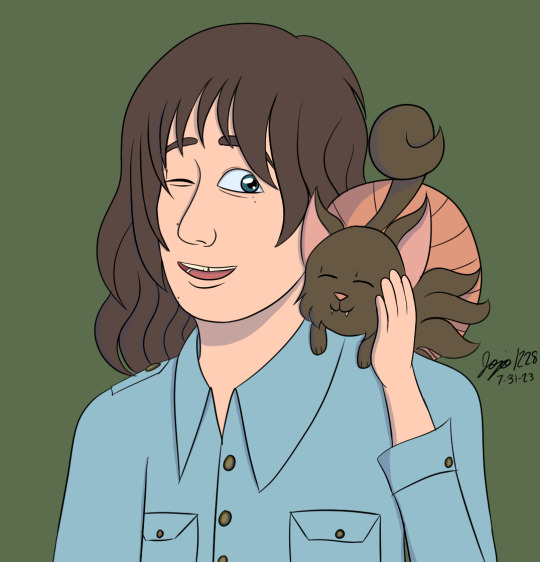
So life got busy for me this year (graduated college, moved into my first apartment and have been working a full-time job, but that doesn't mean I've been completely unable to draw. I just haven't had as much time or motivation to do it as much I would like T_T
Anyway, my friend @gizmocrate-werecrow and I have a Pokemon AU and one of the many, MANY rock stars we've decided to include is Fran O'Toole. Most of you wouldn't have heard of him, but that's okay (I'm used to my obsessions being on the niche side at this point). My impetus for including him (and the rest of the Miami) in this AU was that they really, REALLY deserved better.

(L-R: Stephen Travers, Tony Geraghty, Ray Millar, Brian McCoy, Fran O'Toole, and Des Lee)
I know that giving Fran a pumpkaboo is probably a bit of an oddball move considering he is a dog person (one of the handful of details of his actual life I've been able to dig up), but at the time we made that choice, we didn't know much about these guys. And let's be real, even knowing that now, I'd make the same choice all over again.
Her name is Pumpykins btw. I know Pumpkaboos don't technically have pawsies, but I'm a cat person irl so I wanted them anyway. That and I was also taking a lot of cues from people who draw Pumpkaboos as "cats living in floating pumpkins." Pumpykins herself is a bit mischievous, and also loves snuggles (kinda like my parents' cat Willow, who loves hanging out with me, or at least in my old room).
Also while I technically finished this on the anniversary of the massacre, this was actually me redrawing a sketch I'd done a month prior with a set of markers I got at Walmart.
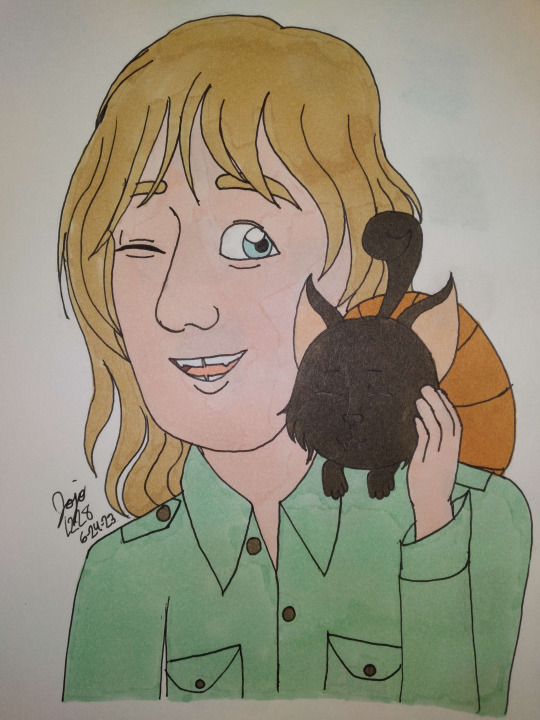
Turns out using a reference (or at least a better light source) does wonders for my drawing. But the main reason Fran went from blond in one drawing to brunette in the finished product is because the colorization in various photos can be a bit... inconsistent.
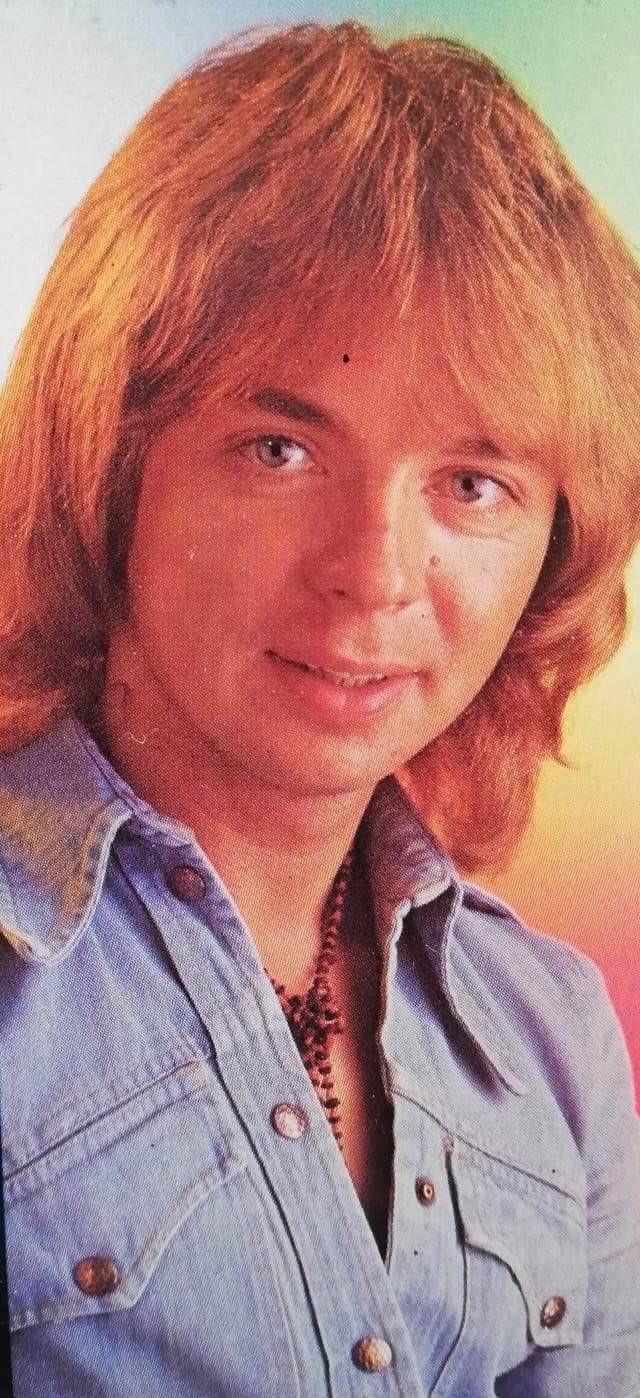
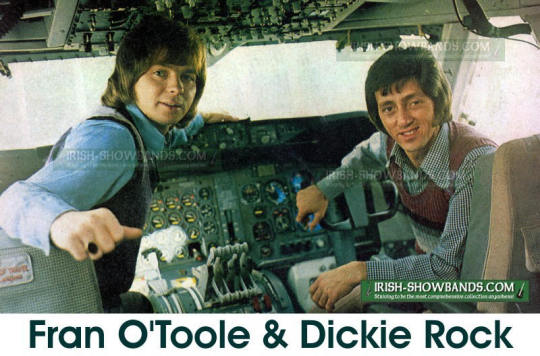
A good way to drive perfectionists like me insane.
(Reblog, don't repost)
#my art#fran o'toole#pokemon#pumpkaboo#miami showband#i refuse to justify my niche obsessions or how i cope with them
2 notes
·
View notes
Photo

This was my real reaction for Groundhog Day
#tony awards 2017#tonys 2017#Groundhog Day the musical#Groundhog Day#katy Geraghty#i am so proud of her#I can only IMAGINE what my reaction is gonna be when I see her perform live next month
1 note
·
View note
Photo









This week marks the 60th anniversary of Julie Andrews’ wedding to first husband, Tony Walton in May 1959. Here in the Parallel Julieverse, we generally avoid discussing Julie’s private life as we believe it is…well…private. However, the vortex of media attention surrounding stars like Julie means that the divide between public and private isn’t always easy to discern, let alone respect. The torrent of studio PR, interviews, magazine profiles, biographies, gossip columns and candid exposes that saturate our celebrity-obsessed media push the personal lives of stars firmly into the public limelight and, by so doing, make off-screen knowledge as integral to a star's image or ‘persona’ as their on-screen roles and public performances (DeCordova 1990; Jerslev and Mortensen 2018).
Like most stars, Julie is no stranger to celebrity culture’s constitutive demand for “the public performance of private selves” (Dyer: 15). Even in her earliest years as a budding child star, she was subject to a probing media inquiry into her private family life. In her memoirs Julie recalls how, at age 12 after the opening night of Starlight Roof, members of the press, eager for a story about the new “prima donna in pigtails,” followed her home, taking photographs as she played in her bedroom and “bombarding me with questions” (Andrews: 80).
While this scrutiny of the private lives of stars is a common aspect of celebrity media at large, it assumes a particularly pronounced form in relation to female stars. Christine Geraghty (2000) observes that longstanding cultural associations “between women and the private sphere of relationships and domesticity” motivate a widespread, even obsessive, media concern with female stars’ off-screen domestic lives in a way that isn’t typically the case for their male counterparts (186). "Stories of love affairs, weddings and divorces” are the default register for pop media representations of female stars, Geraghty notes––a soap opera-like narrative economy that positions female stars as public figures whose cultural legibility, and possibly even value, is tethered to their private roles as wives, mothers, daughters, lovers (ibid).
It is in this context that we can situate Julie’s 1959 wedding to Tony Walton. Dubbed “the show business wedding of the year” (Marlborough and Court: 5), the event was accompanied by an almost frenzied degree of media attention, making headline news in the UK and reported widely via international news-services around the world. It was the culmination of a long gestating "soap opera” that had surrounded the pair’s relationship and been played out in regular instalments across the pages and columns of the Anglo-American celebrity press.
Throughout her all-important Broadway years as Julie made the transition to international stardom in, first, The Boy Friend and, then, My Fair Lady, media commentators were seemingly obsessed with her “off-stage” romantic liaisons. Interviewers routinely quizzed the star about her love life and gossip columnists linked her with a veritable revolving door of suitors, real or otherwise:
“A boy friend? Yes. Julie has one. He’s a twenty-four-year-old Canadian actor she met in England” (Crane, February 1955: 7)
“Julie Andrews, star of The Boy Friend has a new ditto: Dr Stanley Behrman, a young oral surgeon who treats the perils of such belles as Bette Davis and Bobo Rockfeller” (Kilgallen, March 1955: 16)
“The real Boy Friend in pretty Julie Andrews’ life is a TV actor in Toronto. He calls her from there almost every evening” (Kilgallen, April 1955: 30)
“Julie Andrews and Neil McCallum talking marriage” (Sullivan, November 1955: 27C)
By 1956, the young star was already complaining openly that, “People link you and unlink you. They tie you with this person and knot you up with the next one” (Freudenheim, 11-B).
Here it is worth recalling the extent to which Julie’s star image in this era was invested in one of the most resonant narratives of popular feminine romance and sentimental domesticity: Cinderella. As star of My Fair Lady, a particularly influential iteration of the Cinderella fable –– to say nothing of the whole framing narrative of rags-to-riches, Walton-on-Thames to New York, star-is-born mythology –– Julie emerged in the 1950s as what Maya Cantu (2015) calls “the decade’s Cinderella ideal” (162). And what is Cinderella without a Prince Charming?
Small surprise, then, that media tongues were set wagging and public hearts fluttering when Tony Walton, Julie’s childhood sweetheart from Walton-on-Thames, came to New York to visit the star during the early run of My Fair Lady in April 1956. Despite Julie’s protestations they were “just friends” (Freudenheim: 11B), the local press quickly cast the pair as leads in a romantic fairy tale: “Julie Andrews, the Fair Lady leading lady, and her betrothed, Tony Walton of London” (Winchell, April 1956: 4). What followed was a two-year saga of “on again-off again” romantic intrigue played out in the gossip pages:
“Julie Andrews and Tony Walton picking the date” (Sullivan, May 1956: 45)
“Julie Andrews, the dazzler of My Fair Lady is delighted by the visit of her best beau, British artist Tony Walton. But she longs for him to find a stage designing job that would keep in the U.S. for a while” (Kilgallen May 1956: 38).
“It’s been denied on this side of the Atlantic, but London’s theatrical set is buzzing with the rumor that Julie Andrews…is secretly married to British Tony Walton” (Kilgallen, November 1956: 14)
“Julie Andrews tells friends she’s fixing up her apartment for two. Could it be that a merger with Tony Walton is closer?” (Walker, February 1957: 39).
“The British newspapers are crowing happily over the fact that, although Julie Andrews has become a big star in the U.S., she isn’t making the mistake of marrying a Yankee. Julie remains true to her British boy-next-door, young Tony Walton” (Kilgallen, April 1957: 16).
“Is there a wedding in the offing for Julie Andrews?…No, said Julie, from New York last night. But her 15-ear-old brother, Donald told me earnestly: ‘She’s going to announce her engagement as soon as she comes home in April’” (Fielding, December 1957: 2)
Widely reported on both sides of the Atlantic –– indeed, it even received international attention as far away as Australia (“She is Broadway’s ‘Fair Lady’”: 3) –– the brewing romantic soap opera reached fever pitch in the lead-up to the much-ballyhooed London opening of My Fair Lady in April 1958.
No sooner had Julie touched down at London airport than she was grilled by the waiting media scrum about her relationship with Tony. “Julie Andrews…first hour home was spent denying that she will marry as soon as the show opens,” reported the Daily Express, “I have known the boy I want to marry for 12 years, but we shan’t rush to marry yet” (Lambert: 5). The Daily Mirror made the story its front page news with the declarative headline, “I love him! I love him!! I love him!!!”
“Please clear up all those rumours that Tony and I have had a quarrel….All this business about an on-off romance just isn’t true…We have never quarrelled in our lives, and there has been nobody else for either of us since we fell in love two years ago” (Wilcox: 1).
The fact that the pair were childhood sweethearts from the same small Home Counties village –– as cliched a romantic convention as they come –– intensified public interest in their relationship, while at the same time cementing Julie’s popular image at home as “a nice sensible English girl thoroughly unspoiled by fame” (Wiseman: 10; see also, Nathan: 6).
Even Julie herself was not beyond framing her and Tony’s relationship as a somewhat fanciful storybook romance. In her serialised celebrity memoir published in Woman magazine in May 1958 to coincide with her triumphant return to London, the star drew widely from narrative romance tropes and metaphors to describe the “blossoming” of her and Tony’s love. She even ends the memoir with a fairytale climax where, following the grand London opening of My Fair Lady, the couple are depicted waltzing on the floor of the Savoy Hotel like Cinderella and the Prince:
“At midnight, with Mummie, Uncle Charles, and all my darling family about me, I was at the Savoy and, as I danced with Tony, the orchestra started playing the music from My Fair Lady. The floor cleared and Tony and I were left dancing together, dancing, I felt, in a world of all the dreams and ‘One Days’ come true at last” (Andrews 1958: 51).
Thus, when Julie and Tony finally made public their plans to marry, it came like the pre-scripted climax to a very public fairytale romance, the final chapter in the Cinderella narrative through which Julie’s early star image was so throughly cast:
“Once upon a time there was a spindly-legged, freckle-faced little girl with braces on her teeth named Julie Wells. She lived with her mother and stepfather and brothers and sister in a little house in the country. Of course there was a boy-next-door. The years went by and she grew into a lovely silver-blonde. By this time she was Julie Andrews…She was called ‘the nicest girl in show business.’ And after My Fair Lady she was one of the richest. But like the princesses of fairy tales, riches did not turn her heart from the lad who loved her…Tomorrow they marry in the little village church at Oatlands, Weybridge…They will, undoubtedly, live happily ever after” (Stix: 11).
Sources:
Andrews, Julie. “So Much to Sing About, Part 5.” Woman. 31 May, 1958: 31-35, 48-51.
_____________. Home: A Memoir of My Early Years. London: Weidenfeld & Nicolson, 2008.
Cantu, Maya. American Cinderellas on the Broadway Musical Stage: Imagining the Working Girl from Irene to Gypsy. London: Palgrave MacMillan, 2015.
Cottrell, John. Julie Andrews: The Story of a Star. London: Arthur Barker, 1968.
Crane, Lionel. “Julie, The Broadway Bombshell.” Daily Mirror. 8 February 1955: 7.
DeCordova, Richard. Picture Personalities: The Emergence of the Star System in America. Urbana: University of Illinois Press, 1990.
Dyer, Richard. Heavenly Bodies: Film Stars and Society. New York: St Martins Press, 1986.
“Fair Lady Andrews Plans to Marry.” Evening Sun. 6 May 1958: 3.
Fielding, Henry. “Julie’s No.” Daily Herald. 11 December 1957: 2.
Freudenheim, Milt. “American Success Startles British Star Julie Andrews.” Chicago Daily News. 19 April 1956: 11B.
Geraghty, Christine. “Re-examining Stardom: Questions of texts, bodies and performance.” In Gledhill, Christine and Williams, Linda, eds. Reinventing Film Studies. London: Arnold, 2000.
Jerslev, Anne and Mortensen, Mette. "Celebrity in the Social Media Age: Renegotiating the Public and the Private.” In Elliott, Anthony, ed. Routledge Handbook of Celebrity Studies. London: Routledge, 2018.
Killgallen, Dorothy. “Broadway Grapevine.” Star-Gazette. 15 March 1955: 16.
Killgallen, Dorothy. “Broadway Grapevine.” Star-Gazette. 7 April 1955: 36.
Killgallen, Dorothy. “Voice of Broadway.” Star-Gazette. 10 May 1956: 38.
Killgallen, Dorothy. “Voice of Broadway.” Star-Gazette. 12 November 1956: 14.
Killgallen, Dorothy. “Voice of Broadway.” Star-Gazette. 12 April 1957: 16.
Lambert, John. “Fair Lady Julie is Home––Marriage? Not Yet.” Daily Express. 7 April 1958: 5.
Lowe, Shirley. “The Boy Friend’s Girl Friend’s Great-Grandmother.” Daily Express. 4 October 1955: 3.
Marlborough, Douglas and Court, Monty. “PictureMail Goes to the Stage Wedding of the Year.” Daily Mail. 11 May 1959: 5.
Nathan, David. “The Last Time I Saw Julie.” Daily Herald. 8 April 1958: 6.
“She is Broadway’s ‘Fair Lady’.” The Sydney Morning Herald. ‘Women’s Section.’ 5 July 1956: 3.
Stix, Harriet. “Rich-Girl Julie Weds Boy Next Door.” Daily Express. 9 May 1959: 11.
Sullivan. Ed. “Little Old New York.” Daily News. 4 November 1955: 27C.
Sullivan. Ed. “Little Old New York.” Daily News. 7 May 1956: 45.
Walker, Danton. “Broadway.” Daily News. 25 February 1957: 39.
Wilcox, Dennis. “I Love Him! Says Julie Andrews” Daily Mirror. 7 April 1958: 1.
Wilson, Cecil. “Pocket Money Star Stops the Show.” Daily Mail. 24 October 1947: 3.
Winchell, Walter. “On Broadway.” The Post-Star. 26 April 1956: 4.
Winchell, Walter. “Broadway Cinderellas.” Daily Times. 25 June 1956: 4A.
Wiseman, Thomas. “Has Success Spoiled Julie Andrews?” Evening Chronicle. 17 April 1958: 10.
© 2019 Brett Farmer All Rights Reserved
#julie andrews#tony walton#My Fair Lady#cinderella#star#1950s#female stars#old hollywood#classic film#musical theatre
51 notes
·
View notes
Text
Off The Fence: Champion Chase and Ryanair preview as the panel cast their eye on Fakir D'Oudairies, Goshen and Teahupoo | Racing News
Off The Fence: Champion Chase and Ryanair preview as the panel cast their eye on Fakir D’Oudairies, Goshen and Teahupoo | Racing News
The Off The Fence panel are back to review Saturday’s Ascot Chase as well as taking a look ahead to the Champion Chase and Ryanair Chase at the Cheltenham Festival. In episode 13, Barry Geraghty, Tony Keenan and host Vanessa Ryle debate whether Fakir D’Oudairies is a genuine Ryanair Chase contender and also preview the Champion Chase. The trio also take a look back at the performances of the…
View On WordPress
0 notes